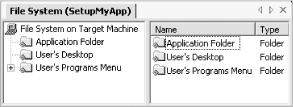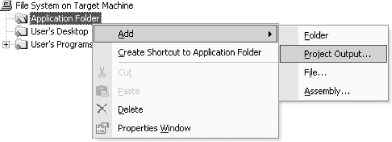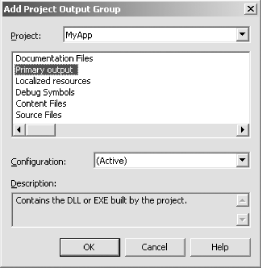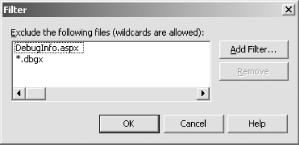6.7 File System View
All applications need to copy one or more files onto the target computer. Visual Studio .NET's Setup project File System view lets you choose which files will be installed and where they will go. Figure 6-12 shows a typical File System view in a normal Setup project. (Web Setup projects have different defaultsthey just have a single folder labeled Web Application Folder.)
Figure 6-12. File System view

The tree on the left of the view represents various folders on the target machine. Folders are never referred to by their exact path, as hardcoding paths into installers is bad practice. System directories tend to be in different places from one machine to the next. (For example, the Windows directory might be C:\WINNT or D:\WINDOWS.) Forcing a particular installation path for the application is also bad practiceyou should let users choose where to put the program. The exact path for all folders will therefore be determined during installation.
Visual Studio .NET therefore supports a number of predefined abstract folders. For example, the Application Folder shown in Figure 6-12 represents the folder chosen by the user when installing the application. (By default, this is typically, but not necessarily, C:\Program Files\Company Name\Application Name.) You would usually put your program's executable files in here. For Web Setup projects, you will instead see a Web Application Folder, which represents the virtual directory into which the application is installed.
You can add other folders by choosing from the Add Special Folder submenu of the "File system on target machine' node"s context menu. Most of the standard system directories are supported. Table 6-3 describes each special folder.
|
Folder |
Use |
|---|---|
|
Common Files |
Where components shared between applications can be installed. Usually C:\Program Files\Common Files. |
|
Fonts |
The system fonts directory. Typically C:\Windows\Fonts. |
|
Program Files |
Where applications are usually installed. This is typically C:\Program Files. |
|
System |
The Windows system directory. Usually C:\Windows\System32. |
|
User's Application Data |
Per-user application-specific data in the user's profile. Typically C:\Documents and Settings\<username>\Application Data. |
|
User's Desktop |
The user's desktop. This is usually C:\Documents and Settings\<username>\Desktop. |
|
User's Favorites |
The user's Favorites menu. Typically C:\Documents and Settings\<username>\Favorites. |
|
User's Personal Data |
Per-user My Documents directory. This is usually C:\Documents and Settings\<username>\My Documents. |
|
User's Programs |
The Programs section of the user's Start menu. Typically C:\Documents and Settings\<username>\Start Menu\Programs. |
|
User's Send To Menu |
The Send To submenu on the Windows Explorer file context menu. This is usually C:\Documents and Settings\<username>\SendTo. |
|
User's Start Menu |
The user's start menu. Typically C:\Documents and Settings\<username>\Start Menu. |
|
User's Startup Folder |
Files to be executed when the user logs on. This is usually C:\Documents and Settings\<username>\Start Menu\Programs\Startup. |
|
User's Template Folder |
Holds new document templatesused for the New submenu of Windows Explorer. Typically C:\Documents and Settings\<username>\Templates. |
|
Windows Folder |
The Windows directory. Usually C:\Windows. |
|
Global Assembly Cache Folder |
The .NET Global Assembly Cache. Files added to this directory should be strongly named .NET components. They will be added to the GAC at installation time. |
|
Module Retargetable Folder (Merge Modules only) |
A folder whose destination may be specified by any application that includes this merge module. Some merge modules don't care where their files are installed so long as they are installed somewhere. They allow the exact location to be chosen by the application that is using the merge module. If you want to allow the same flexibility for your own merge modules, put the files in this folder. When you use a module that has retargetable files in an installer, you can choose where to place the files with the Properties window. Select the merge module in the project and expand its MergeModuleProperties property. Modules with retargetable output will have a child ModuleRetargetableFolder property, allowing you to choose where to put the merge module's output. |
Having decided which directories you wish to populate during installation, you must tell Visual Studio .NET what files it should place in those directories. You do this by selecting the folder and then selecting Add from the context menu.
As Figure 6-13 shows, you have several choices. You can add a new subdirectory with Folder. You can install any file you like. The Assembly item lets you install a .NET component and get Visual Studio .NET to automatically determine which other components it depends upon and install those too. Project Output lets you install components built by other projects in the same solution as your Setup project.
Figure 6-13. Populating folders

6.7.1 Adding Project Output
Whatever else you choose to install on the target machine, you will almost certainly want to copy your program's executable code. The way to do this is to add a Project Output item to the appropriate folder. (For a normal application, this will be the Application Folder. For a web application, it will usually be the Web Application Folder.)
|
When you select Add 
Figure 6-14. Adding project output

For nonweb applications, you will normally want just the Primary Output group (see Table 6-4). The Primary Output is the main file that the project builds. This will usually be either a DLL or an EXE file, depending on the project type. For web applications, you will also want to select Content Filesthis includes .aspx pages and any graphics.
|
|
Output group |
Usage |
|---|---|
|
Documentation Files |
C# source files can be annotated with special comments (starting with ///). The C# compiler strips out this information to build an XML documentation file. Visual Studio .NET is able to use these files to provide documentation tooltips. You would include such output when building a Setup project whose purpose is to install software components on a developer's machine. You would not normally include this output group in anything intended to be installed on an end user's machine. |
|
Primary Output |
The Primary Output is the main file built by the project, usually a DLL or an EXE file. You would normally include this output group in any Setup project. |
|
Localized Resources |
Any satellite resources created for localized versions of an application will be in this output group. You would include this group for any project in which you have created localized resources. |
|
Debug Symbols |
When compiling with debugging enabled, the compiler produces a separate file containing the symbolic information required by the debugger (a .pdb file). This output group contains that information. You would not normally want to redistribute debug symbols. However, sometimes you will not be able to reproduce problems on a developer's machine, in which case it can be useful to install debug symbols on a target machine in order to try and diagnose problems. You would include this group when building a special debugging installation. |
|
Content Files |
Project files that do not get compiled will appear in this group. (This will include any project item with a BuildAction property of Content.) You usually want to include this output group for web applications because .aspx files and graphics are all classed as Content. For other applications, you usually wouldn't include this group. |
|
Source Files |
This group includes all of the source code in the project. You would very rarely include this group. However, if you are diagnosing a problem in situ, this, in conjunction with the Debug Symbols group, would provide a way of installing everything required to do source-level debugging on a machine without having to copy the entire solution across. |
Sometimes, you may wish to include some but not all of the files in an output group. For example, a web application may contain pages that are for debugging purposes and that should not be deployed on a live server. Visual Studio .NET allows you to leave out certain files when installing an output group by setting the output item's ExcludeFilter property. You may add multiple filters with this property. Each filter can be either a specific file or a filename containing wildcards, as Figure 6-15 shows.
Figure 6-15. Setting an ExcludeFilter

6.7.1.1 COM registration
If you have a project that builds a COM component, you will need to make sure that the component is registered correctly when it is installed. You can ensure this by setting the project output's Register property. The Properties page allows you to select the Register property's value from a listbox; the available options are vsdrpNoRegister, vsdrpCOM, vsdrpCOMRelativePath, vsdrpCOMSelfReg, and vsdrpFont. (vsdrpFont is used for installing new fonts and is not used for COM registration.)
To install a COM component in the usual way, making it available to any application on the machine, select the vsdrpCOM option. Isolated registration is also supportedyou can install the component in such a way that it will be accessible only to your application, and not to the whole system. For this, you should choose the vsdrpCOMRelativePath option. (This works only when the target system is Windows 2000 or later.)
vsdrpCOM and vsdrpCOMRelativePath allow Windows Installer to perform all registry updates. Visual Studio .NET will make sure that all of the appropriate registry configuration information is stored in the Windows Installer file. However, it is sometimes vitally important that a component be allowed to do its own registration. (For example, it may do more in its DllRegisterServer function than just updating the registry.) In this case, you should choose the vsdrpCOMSelfReg option. As a rule, though, it is better not to use vsdrpCOMSelfReg if possibleyou should avoid creating COM components that require it, because Windows Installer cannot robustly repair or roll back installations that use this technique, as it doesn't know what configuration changes are made by the component.
6.7.2 Adding Files
If you wish to install a specific file
that is not a part of a project, you can do this with the Add

|
6.7.3 Adding Assemblies
If you want to add a .NET assembly
for which you don't have a merge module, you can at
least get Visual Studio .NET to do automatic dependency analysis for
the component. Instead of adding it as a file, select the Add

Most of the time you will not need to do thisif you add a project reference to the component in the usual way, Visual Studio .NET will detect the dependency automatically, and you will not need to add it manually. You would need to add it this way only if the reference was not automatically detectable (e.g., you are using the assembly entirely through the .NET Reflection API).
6.7.4 Adding Merge Modules
If your application depends on another component, you should include the merge module for that component in your installer. Strictly speaking, merge modules are not added to the File System view. This is because merge modules are self-containedthey know where the files they contain need to be installed.
You can add a merge module to the project explicitly with the Add

This option is not available in a Merge Module Setup project, because
you cannot nest a merge module inside another. However, if your
component does depend on another component, you can add a reference
to its merge module with the project context menu's
Add 








